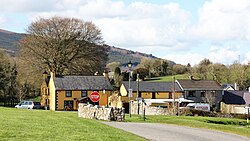St. Mullin's
|
St. Mullins Tigh Moling
|
|
|---|---|
| Village | |
 |
|
| Location in Ireland | |
| Coordinates: 52°29′22″N 6°55′44″W / 52.489366°N 6.928851°WCoordinates: 52°29′22″N 6°55′44″W / 52.489366°N 6.928851°W | |
| Country | Ireland |
| Province | Leinster |
| County | Carlow |
| Irish Grid Reference | S7280838050 |
St. Mullins (Irish: Tigh Moling, formerly anglicised as Timoling or Tymoling) is a village on the eastern bank of the River Barrow in the south of County Carlow, Ireland. It is less than 2 km off the R729 regional road.
The village is named after Saint Moling (or Mo Ling, 614–697), who founded a monastery there in the early 7th century. The monastery was said to have been built with the help of "Gobán Saor", the legendary Irish builder. In the 8th-century manuscript, known as "The Book of Mulling", there is a plan of the monastery - the earliest known plan of an Irish monastery - which shows four crosses inside and eight crosses outside the circular monastic wall. It is said that St Moling dug a mile-long watercourse with his own hands to power his mill, a task that took seven years. He became Bishop of Ferns, died in 697 and is buried at St. Mullins. The St Moling watercourse is still there, but the original monastery was plundered by the Vikings in 951 and was again burnt in 1138. An abbey was later built on the site. A 9th-century high cross, showing the Crucifixion and a Celtic spiral pattern, stands outside the remains of the abbey. There are also the remains of a Norman motte and some domestic medieval buildings, including one that has an unusual diamond-shaped window. St Moling's Mill and Well are not far away.
In Irish folklore, St. Mullins is said to be the place where Suibhne Geilt dies, after having been welcome in the monastery by Saint Moling himself.
The first reference to a holy well at St. Mullins is to be found in the Annals of Friar Clyn (1348). In those times, the plague swept across Ireland and pilgrims visited the holy well in St. Mullins out of fear of the plague. They would circle the well in a clockwise direction, known as circumambulation, while reciting prayers.
...
Wikipedia

